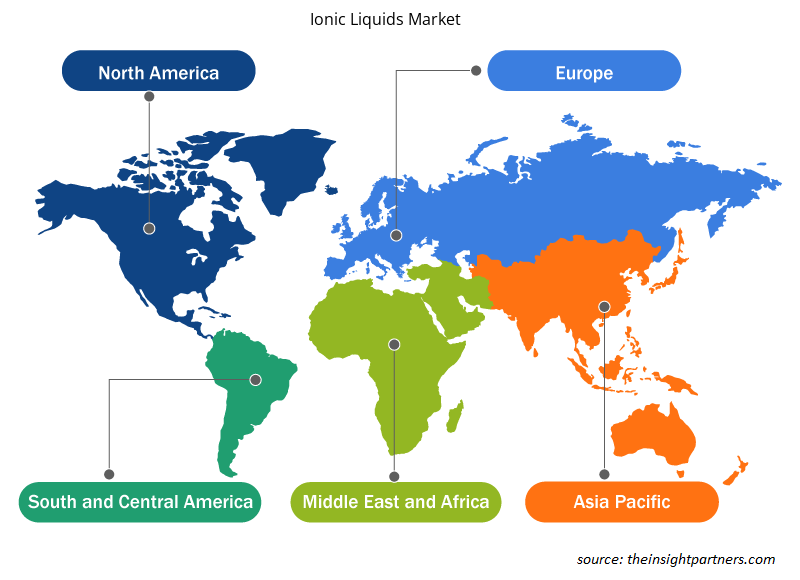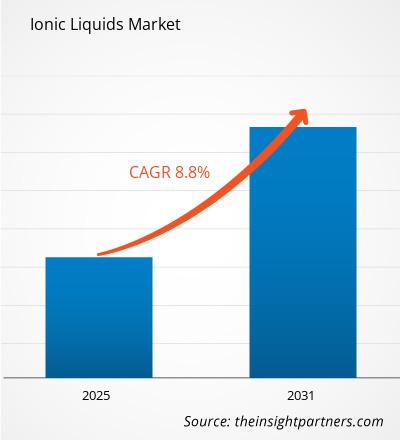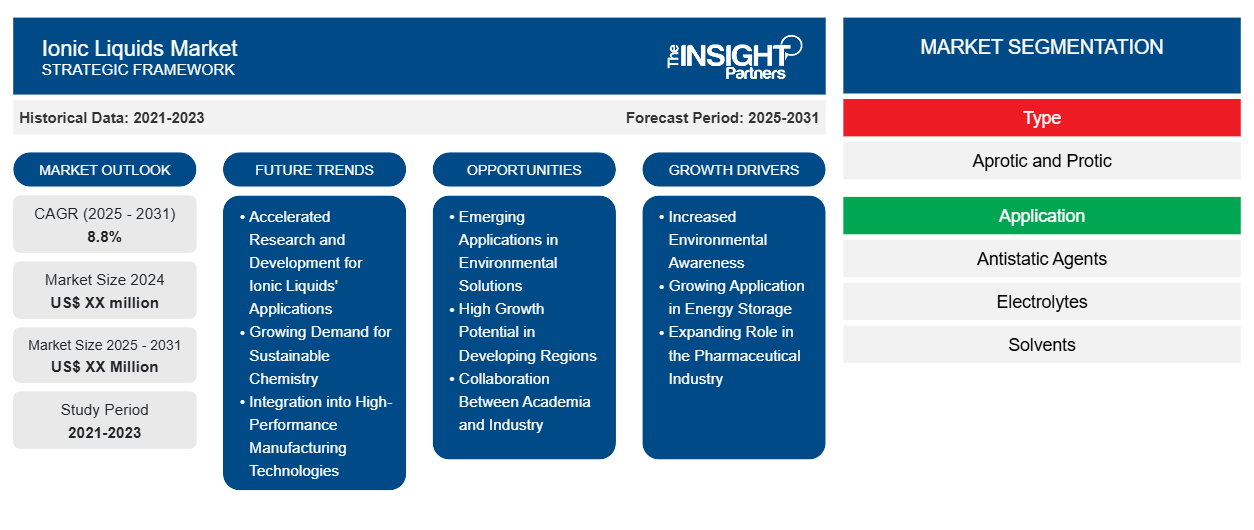预计离子液体市场在 2023 年至 2031 年期间的复合年增长率为 8.8%,市场规模将从 2023 年的 XX 百万美元扩大到 2031 年的 XX 百万美元。
报告按类型(非质子和质子)细分。报告进一步根据应用(抗静电剂、电解质、溶剂、PCO2 吸收剂、润滑剂等)进行了分析。报告范围涵盖五个地区:北美、欧洲、亚太、中东和非洲、南美和中美洲以及每个地区下的主要国家。全球分析进一步细分为区域和主要国家。报告以美元为单位提供上述分析和细分的价值。
报告目的
The Insight Partners 的《离子液体市场》报告旨在描述当前形势和未来增长、主要驱动因素、挑战和机遇。这将为各种业务利益相关者提供见解,例如:
- 技术提供商/制造商:了解不断变化的市场动态并了解潜在的增长机会,从而能够做出明智的战略决策。
- 投资者:对市场增长率、市场财务预测以及整个价值链中存在的机会进行全面的趋势分析。
- 监管机构:监管市场政策和警察活动,旨在最大限度地减少滥用行为,维护投资者的信任和信心,维护市场的完整性和稳定性。
离子液体市场细分
类型
- 质子和质子
应用
- 抗静电剂
- 电解质
- 溶剂
- PCO2 吸收剂
- 润滑剂
定制此报告以满足您的需求
您可以免费定制任何报告,包括本报告的部分内容、国家级分析、Excel 数据包,以及为初创企业和大学提供优惠和折扣
-
获取此报告的关键市场趋势。这个免费样品将包括数据分析,从市场趋势到估计和预测。
离子液体市场增长动力
- 环保意识增强:环保意识增强推动了对离子液体作为绿色溶剂的需求。它们大大减少了化学工艺中的挥发性有机化合物,符合可持续发展目标。在这种情况下,行业寻求最环保的替代品来代替传统溶剂,因此离子液体是许多应用的首选。
- 储能应用日益广泛:离子液体因其热稳定性和电化学性质,在储能领域得到越来越广泛的应用。此类化合物通过提高能量密度和安全性来提高电池和超级电容器的效率。随着可再生能源技术的进步,对稳定高效离子液体的需求可能会增加。
- 在制药行业中的作用不断扩大:制药行业仍在不断增加离子液体在药物配方和输送中的应用。离子液体通过提高活性药物成分的溶解度和稳定性为新药带来附加值。因此,创新和投资不断涌入离子液体研究,旨在提高药物疗效和患者治疗效果。
离子液体市场未来趋势
- 加速离子液体应用的研究和开发:高额的研发投入使离子液体的知识随着其应用而增长。研究人员正在催化、萃取和材料科学等广泛领域发明新配方和新应用。研发重点的增加正在加速更灵活、性能更佳的离子液体的开发。
- 对可持续化学的需求不断增长:对可持续化学的需求不断增长,这迫使工业出于环保考虑而使用离子液体。这种溶剂可以减少浪费,并降低通过不同化学工艺步骤产生的生态足迹。从这个角度来看,离子液体的引入符合世界追求工业可持续发展的主要战略之一,即更环保的工业实践。
- 融入高性能制造技术:离子液体越来越多地融入高性能制造技术,如 3D 打印和纳米技术。此类液体具有低挥发性和特性可调性等特性,可提高这些制造工艺的质量效率。因此,最近的趋势表明,在工业内外的新形式制造技术中,离子液体的使用越来越广泛。
离子液体的市场机会
- 环境解决方案中的新兴应用:离子液体在碳捕获、可再生能源和纳米材料等新兴应用中具有广阔的应用前景。随着各行各业进一步寻求应对环境挑战的创新解决方案,离子液体的独特性质将为高效分离过程、能量存储和新材料开发提供有效的替代方案,从而推动未来市场的增长。
- 发展中地区的高增长潜力:离子液体市场在发展中地区具有高度增长性。随着工业化和环境法规的出台,对清洁技术的需求日益增长。一旦人们意识到离子液体,这些清洁溶剂将被发展中地区的工业更快地采用,这反过来又将为市场扩张和合作开辟更多的途径。
- 产学研合作:产学研合作研究加速离子液体新应用的开发。产学研合作充分利用双方优势和资源,鼓励创新,将研究成果转化为实用解决方案。产学研合作有助于将学术发现与市场需求相结合,从而推动进步,扩大离子液体的商业潜力。
离子液体市场区域洞察
Insight Partners 的分析师已详细解释了预测期内影响离子液体市场的区域趋势和因素。本节还讨论了北美、欧洲、亚太地区、中东和非洲以及南美和中美洲的离子液体市场细分和地理位置。

- 获取离子液体市场的区域特定数据
离子液体市场报告范围
| 报告属性 | 细节 |
|---|---|
| 2023 年的市场规模 | XX 百万美元 |
| 2031 年市场规模 | XX 百万美元 |
| 全球复合年增长率(2023 - 2031) | 8.8% |
| 史料 | 2021-2022 |
| 预测期 | 2024-2031 |
| 涵盖的领域 |
按类型
|
| 覆盖地区和国家 |
北美
|
| 市场领导者和主要公司简介 |
|
离子液体市场参与者密度:了解其对业务动态的影响
离子液体市场正在快速增长,这得益于终端用户需求的不断增长,而这些需求又源于消费者偏好的不断变化、技术进步以及对产品优势的认识不断提高等因素。随着需求的增加,企业正在扩大其产品范围,进行创新以满足消费者的需求,并利用新兴趋势,从而进一步推动市场增长。
市场参与者密度是指在特定市场或行业内运营的企业或公司的分布情况。它表明在给定市场空间中,相对于其规模或总市场价值,有多少竞争对手(市场参与者)存在。
在离子液体市场运营的主要公司有:
- 巴斯夫
- 索尔维
- 默克公司
- 斯特雷姆
- 索尔维奥尼克
- 丙酸
免责声明:上面列出的公司没有按照任何特定顺序排列。

- 了解离子液体市场主要参与者概况
主要卖点
- 全面覆盖:报告全面涵盖了离子液体市场的产品、服务、类型和最终用户的分析,提供了整体概况。
- 专家分析:报告基于对行业专家和分析师的深入了解而编写。
- 最新信息:该报告涵盖了最新信息和数据趋势,确保了其与业务的相关性。
- 定制选项:此报告可以定制以满足特定客户要求并恰当地适应业务策略。
因此,离子液体市场研究报告有助于引领解读和了解行业情景和增长前景。尽管可能存在一些合理的担忧,但本报告的总体优势往往大于劣势。
- 历史分析(2 年)、基准年、预测(7 年)及复合年增长率
- PEST和SWOT分析
- 市场规模、价值/数量 - 全球、区域、国家
- 行业和竞争格局
- Excel 数据集
近期报告
客户评价
购买理由
- 明智的决策
- 了解市场动态
- 竞争分析
- 客户洞察
- 市场预测
- 风险规避
- 战略规划
- 投资论证
- 识别新兴市场
- 优化营销策略
- 提升运营效率
- 顺应监管趋势























 获取免费样品 - 离子液体市场
获取免费样品 - 离子液体市场